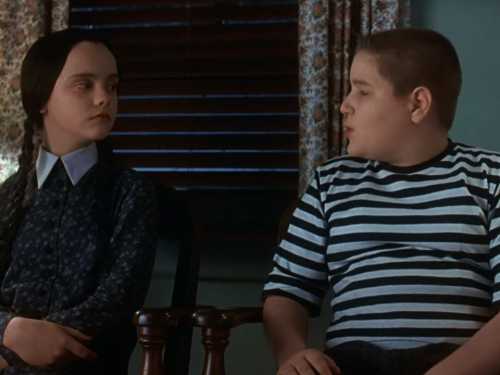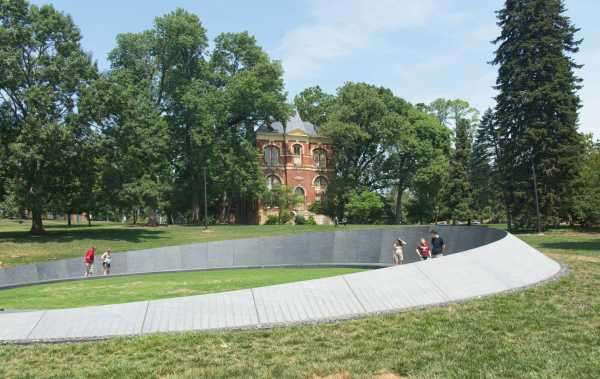
The inauguration of the Vietnam Veterans Memorial in Washington 40 years ago marked the advent of a new, anti-monumental idiom in the nation’s commemorative art. “The Wall,” as Maya Lin’s chevron-shaped creation is known, provoked hostility among some Vietnam vets precisely because it was not a traditional monument symbolizing the valor of warriors who loyally served their country in an unpopular conflict. Inscribed with the names of America’s more than 58,000 war dead listed in the chronological order of their deaths, Lin’s wall had nothing to do with martial valor. It was about loss. It was about healing. Its anti-monumental character, in other words, was tied to a therapeutic aim.
Even so, veterans disinclined to get with the therapeutic program—many of whom were service-academy graduates—had to be mollified with Frederick Hart’s realist sculpture, Three Servicemen, which was added to the memorial precinct in 1984, along with a bronze flagpole bearing the insignia of the nation’s armed forces.
Advertisement
But Lin’s memorial of reflective black granite made a deep impression on the public and attracted an enormous number of visitors. In 1994, the New York Times’s religion correspondent hailed her wall as “something like a sacred shrine,” noting that the memorial was attracting more visitors than the majestic monument to Abraham Lincoln close by. That ceased to be the case years ago, which is natural, because the impact of the wall’s novelty has inevitably diminished, as has the number of people with close ties to the names. In 2021 the Lincoln Memorial received 5.8 million visitors, the Vietnam 3.6 million.
The anti-monumental idiom has endured, however, and the debt owed by the University of Virginia’s new Memorial to Enslaved Laborers to Lin’s wall is pretty obvious. Completed in 2020, year of the civil disorder arising from the death of George Floyd, the UVA memorial is situated at the foot of a grassy declivity a short distance from Thomas Jefferson’s Rotunda and Lawn. Whereas Lin’s wall is embedded in the landscape of the National Mall, the enslaved laborers memorial consists of two concentric rings of dark-grey granite, the outer one being a freestanding wall whose concave, gently sloped inner face is scored with several thousand thin gashes, or “memory marks,” each of which corresponds to a slave who toiled at the university prior to the Civil War’s conclusion. Five hundred seventy-seven of the marks are accompanied by names, another 311 by indications of kinship or trade, and the rest await identifications.
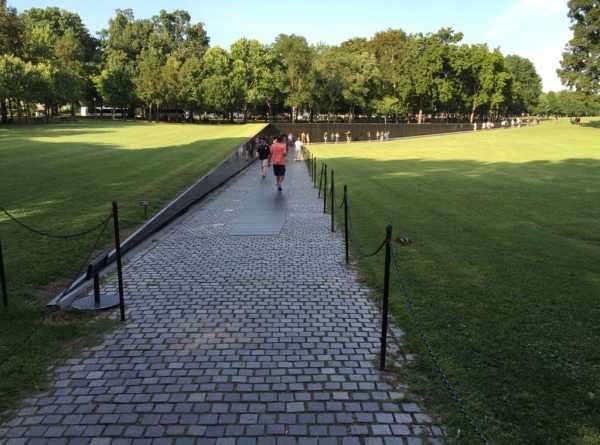
Vietnam Veterans Memorial (1982). Photo by Catesby Leigh
The Vietnam wall increases in height as the visitor descends to the vertex, where it is ten feet tall. You don’t descend within the enslaved-laborers memorial, but the outer wall, configured as a ring with a gap at the entrance, rises symmetrically from the ground on each side to reach a maximum height of eight feet where its rear elevation aligns with the entrance. The inner ring, itself broken at the memorial entrance, also increases somewhat in height while serving as a bench for contemplation of the wall, from which it is separated by a stone pavement. Behind the bench, a narrow stream of water flows over a curving timeline featuring particular events within the university’s slave community—some of them evoking brutal or callous mistreatment—while including historical developments affecting the “peculiar institution.”
The inner ring encloses a circle of grass conceived as a performance space, so that the memorial and its landscape setting double as a kind of amphitheater. The memorial’s configuration has been described as symbolizing a broken shackle and the “ring dance” slaves engaged in, but you have to be told that. Its generally abstract form is rather baffling to the uninitiated. The concrete-framed outer wall’s exterior granite panels are vertically scored so as to create deep linear shadows whose intended symbolism is a mystery. The panels are also etched with an understated faceted pattern that might suggest mountains or clouds. One wonders if the proximity of the Blue Ridge explains the motif.
Advertisement
Finally, a discordantly photographic etching of a pair of eyes becomes visible on the outer wall’s exterior when the light is right. The eyes are situated off-center, not at the wall’s highest point. They were derived from a photograph of Isabella Gibbons, an enslaved cook who eventually became a teacher at a freedmen’s school. Her bitter reminiscence is inscribed on the aqueous timeline:
Can we forget the crack of the whip, cowhide, whipping post, the auction-block, the hand-cuffs, the spaniels, the iron collar, the negro-trader tearing the young child from the mother’s breast as a whelp from the lioness? Have we forgotten that by those horrible cruelties, hundreds of our race have been killed? No, we have not, nor ever will.
So what we have here is a therapeutic memorial intended to help heal the historical wounds inflicted by slavery, and, as a gathering space, to help challenge the “systemic racism” of our day. In formal terms, perhaps the best thing that can be said about the memorial is that it doesn’t sprawl, as our latter-day memorials tend to do. It is spatially well defined.
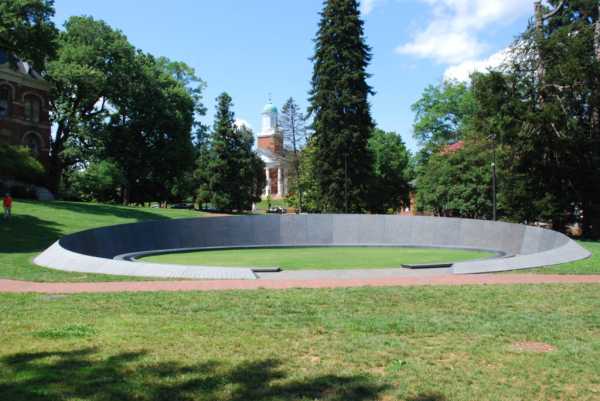
Memorial to Enslaved Laborers at the University of Virginia. Höweler + Yoon, architects. Photo by Catesby Leigh
But its minimalist formal vocabulary is far less effective than the Vietnam wall’s. For starters, the latter doesn’t provoke question marks. You descend along a pavement abutting the wall, and your horizon narrows as the wall grows taller. You see the inscribed names, along with your own reflection in the glossy granite. As you ascend from the vertex, where the panels of names are tallest and the war’s toll most poignant, your horizon widens again, with the Lincoln Memorial or Washington Monument dominating the vista, depending on the direction you’re walking in. For the record, Lin did not intend this procession along the pavement, which was necessitated, together with the closing off of the slope in front of the wall, by serious drainage problems.
But the enslaved-laborers memorial’s baffling vertical scorings and mountain- or cloud-like faceting, along with the eyes and the memory marks themselves (knife cuts?), will have some visitors scratching their heads, as will the divergent treatments of the interior and exterior surfaces of the outer wall—with the exterior possibly registering as an oddly polysemic husk. And why the water running over the inner ring’s timeline? Oh, it recalls the brutal trans-Atlantic crossing and also riverine paths of slaves’ escape from bondage, and even ritual libations. Actually, it seems more like a gimmick employed to liven up a problematically reductionist design. And though employed at a vastly reduced scale, this rivulet reminded me of the shallow moat running around the spacious, roughly oval-shaped landscape memorial to Princess Diana in London’s Hyde Park. There the moat, which encloses a far larger patch of turf, was designed to create contrasting textures in the flowing water. This was perhaps a rather silly way of expressing the more tranquil and more turbulent phases of the princess’s life—and of course here, too, the symbolism has to be explained to us. Fortunately, the enslaved-workers’ memorial makes a great deal more sense than Diana’s.
Needless to say, the Charlottesville memorial is formally exogenous to the historic precinct of the UVA campus in which it is situated. Unlike Jefferson’s classical Rotunda and Lawn, it is not beautiful. I suspect that if enslaved tradesmen—whether they were stonecutters, brick-masons, blacksmiths, or carpenters—who helped build Jefferson’s “academical village” could rise from the dead to inspect the memorial intended to honor them, they might wonder: Why is it not beautiful like the buildings that are the fruits of our toil, buildings that have stood the test of time for two centuries?
Subscribe Today Get weekly emails in your inbox Email Address:
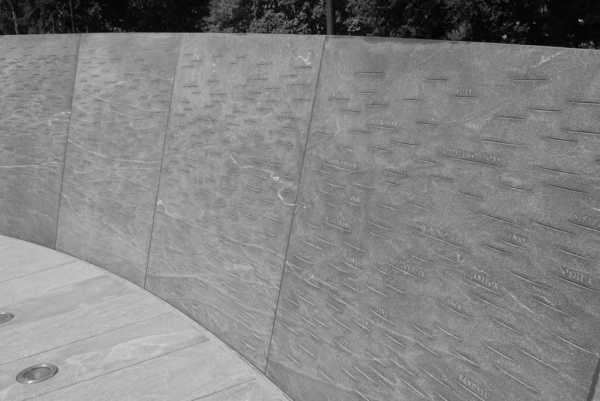
“Memory marks” at the Memorial to Enslaved Laborers. Photo by Catesby Leigh
Would not those enslaved tradesmen vastly prefer to be honored by a memorial conceived within the same classical idiom as the University’s Frank Hume Memorial Fountain, despite the inscription on its enclosing exedra—traditionally known as the Whispering Wall—honoring a businessman and state legislator who served in the Confederate army? As part of its campaign to erase as many vestiges of UVA’s involvement with slaveowners, the Confederacy and Jim Crow as possible, the university has removed the Hume memorial’s inscribed face stones, which of course have been the subject of woke outrage and vandalism. They will soon be replaced with blank stones.
The Memorial to Enslaved Laborers is a highly intellectualized artifact. The classical tradition, on the other hand, arises from a profound, and profoundly civilizing, instinct: to idealize structure in line with a sense of life that runs far deeper than current obsessions with identity politics. That idealizing, metaphysical impulse informs the exquisite proportions and gorgeous porticoes of the Rotunda and Lawn, but it is nowhere to be found in an anti-monument like the enslaved-workers’ memorial. On the contrary, the modernist sensibility informing the memorial’s design suppresses that metaphysical impulse. The contemporary anti-monument’s highest aim is therapeutic—healing the wounds of the past—and political, insofar as it pretends to be the locus of more enlightened community engagement. Time will tell.
Advertisement
Sourse: theamericanconservative.com
